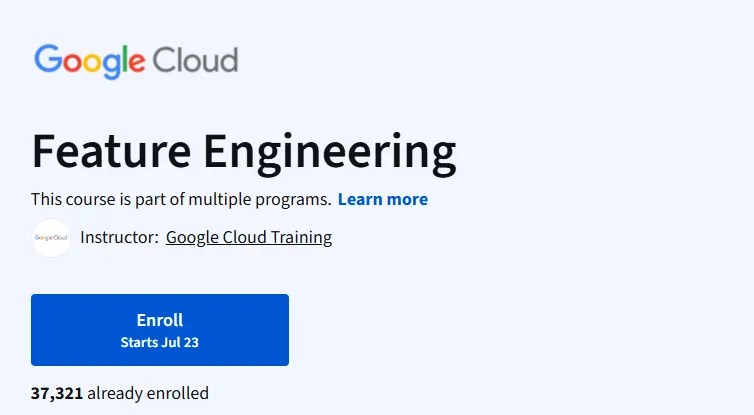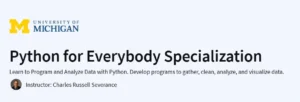Feature Engineering
A hands-on feature engineering course that equips ML practitioners with key GCP and TensorFlow pipelines needed for production-grade model development.
What will you learn in Feature Engineering Course
Understand how to use Vertex AI Feature Store to build, manage, and serve ML features.
Prepare and transform raw data into ML-ready features using BigQuery ML, Keras, TensorFlow, Dataflow, and Dataprep.
Learn about feature transformations like feature crosses, bucketing, and using tf.Transform.
Explore best practices in preprocessing, feature exploration, and enhancing model accuracy.
Program Overview
Module 1: Introduction to Vertex AI Feature Store
⏳ ~0.8 hours
Topics: Overview of what a feature store is, why it’s essential, and its core components.
Hands-on: Watch 6 videos + 1 reading + 1 quiz to learn setup, terminology, and purpose.
Module 2: Raw Data to Features
⏳ ~1 hour
Topics: Identify usable raw data, define feature quality, and establish feature selection criteria.
Hands-on: Review 1 reading + 1 assignment focused on deriving features from raw datasets.
Module 3: Feature Engineering Basics
⏳ ~4 hours
Topics: Contrast ML vs statistics approaches, apply feature transformations in BigQuery ML & Keras, and use crosses, bucketing, and tf.Transform.
Hands-on: Complete labs using BigQuery ML and TensorFlow with practical examples (e.g., housing prices, taxi fares).
Module 4: Advanced Feature Engineering & MLOps
⏳ ~2 hours
Topics: Learn advanced transformations, metadata handling, and integration with ML pipelines (MLOps).
Hands-on: Apply tf.Transform in TensorFlow workflows and integrate features into production pipelines.
Module 5: Course Conclusion
⏳ ~0.5 hours
Topics: Summarize feature engineering best practices, review tools and production integration strategies.
Hands-on: Complete final quizzes and reflect on end-to-end feature design.
Get certificate
Job Outlook
Highly relevant for roles like ML Engineer, MLOps Engineer, and Data Scientist focusing on production-grade ML systems.
Teaches one of the essential skills—feature engineering—widely recognized in roles across data-driven companies.
- Covers modern feature pipelines with Vertex AI Feature Store, BigQuery ML, and tf.Transform.
- Provides hands-on, real-world examples like feature crosses and bucketing.
- Integrates feature engineering best practices with MLOps workflows.
- Intermediate-level; assumes familiarity with ML frameworks and tools.
- Covers fundamental pipelines only—enterprise production deployments require self-study.
Specification: Feature Engineering
|
FAQs
- Intermediate ML knowledge is recommended.
- Familiarity with Python, TensorFlow, and ML workflows is helpful.
- Labs assume you can manipulate datasets and train basic models.
- Beginners can attempt, but may need extra time for coding exercises.
- Prepares you for applying feature engineering in production pipelines.
- Hands-on labs with Vertex AI Feature Store and BigQuery ML.
- Practice transformations like bucketing, crosses, and scaling.
- Integrates feature engineering into end-to-end ML pipelines.
- Provides real-world examples like taxi fare and housing datasets.
- Prepares learners for production-grade ML model deployment.
- Prepares for ML Engineer or MLOps Engineer roles.
- Supports Data Scientist positions focusing on production ML.
- Emphasizes best practices for feature transformation and model accuracy.
- Builds skills relevant for AI/ML pipelines in enterprise settings.
- Enhances portfolio with hands-on feature engineering projects.
- Covers metadata management and feature versioning.
- Introduces integration of features into ML pipelines (MLOps).
- Advanced transformations using tf.Transform.
- Enterprise-level distributed pipelines require additional study.
- Ideal for building production-ready features for ML models.
- Total course duration is ~8–8.5 hours.
- Modules include hands-on labs and practical assignments.
- Labs may take extra time depending on prior ML and coding familiarity.
- Recommended for learners who can dedicate 1–2 hours daily.
- Can be completed within 2–3 days with focused effort.





